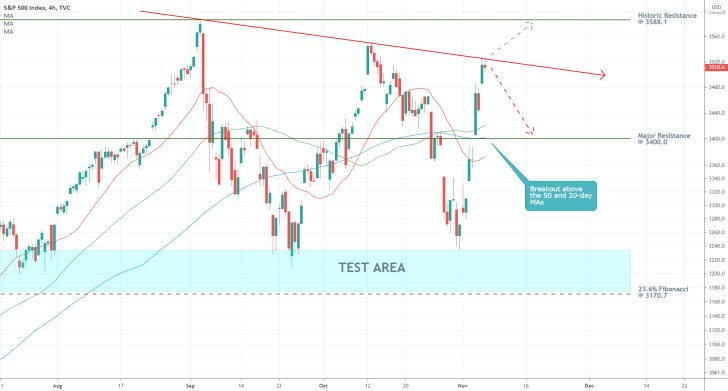
Just a couple of hours earlier, it was revealed that in the state of Georgia, which bears sixteen electoral votes, the tide of the presidential race has turned. Joe Biden now clinches the victory with a marginal lead of several thousand votes.
This republican bastion, which hasn't gone blue since 1992, looks poised to go to Biden this time, in what would deliver the final blow to Trump's ambitions for re-election.
Many experts expected a landslide victory for the democrats according to findings of the preliminary polls, but the overall turnout for the GOP was much bigger than initially anticipated.
Despite Biden's decisive win in the popular vote, where he leads with several million votes, the neck in neck electoral race was interpreted by many as a sign of massive polarization of opinions in the US. This, in turn, was perceived as an additional source of uncertainty for the future of the American democracy and economy.
Yet, such baseless fears are ungrounded in so far as they fail to factor in the changing demographics in the States. Georgia is a perfect example of this, as its unexpected support for Biden is illustrative of people's overwhelming desires for a change, even amongst voters who had historically been leaning towards the GOP.
Despite Trump's premature claims to victory and subsequent calls to stop counting the remaining votes, the democratic institutions in the States have demonstrated stability, which is a good sign for the future wellbeing economy as well.
For markets, what remains is to wait for the outcome of the election to be definitively confirmed, so that they can price in these results without being impeded by any adverse uncertainty.
What remains for the stock market, in particular, is to gradually overcome the fallout from the elections now that most of the aforementioned uncertainty should start to wane.
As can be seen on the 4H chart below, the S&P 500 is about to test the strength of the descending trend line, which was already caused rebounds on two separate occasions in the past.
The prevailingly bullish outlook is affirmed by the fact that the price action managed to break out above the 50-day MA (in green) and the 20-day MA (in red) yesterday, which clears the way for the index to climb towards the historic resistance at 3588.1 once again.
If, however, a third rebound from the descending trend line takes place, the S&P 500 could pull back towards the major resistance (currently support) level at 3400.0, before it finds the necessary bullish commitment to resume trading higher.

Trendsharks Premium
Gold is undergoing a correction, as investors take profits to offset losses from falling stock prices, impacting their margins. However, we anticipate a renewed wave of [...]
The Swiss stock market index is mirroring its global counterparts, such as Germany 40 and US100, experiencing a sharp decline following the announcement of new [...]
We’re analyzing the weekly chart to grasp the broader market trend. Over the past three years, the US30 index has surged by 17,000 points, often resembling a nearly straight [...]
Over the past week, the DAX has experienced a sharp decline, plunging by an astonishing 3,400 points. This downward movement is not isolated, as its international counterparts, such as the UK100 and US100, are also facing significant [...]
EURUSD recently formed a double top at 1.0930, signaling a potential trend reversal, and has since begun a correction. After a 600-pip rally since early March, a pullback at this stage is both expected and healthy. Given these conditions, we are placing a [...]
Since early March, EURJPY has surged nearly 1,000 pips, providing us with several excellent trading opportunities. However, as the rally matures, many early buyers are beginning to take profits, leading to a noticeable slowdown in the uptrend. On Friday, the pair formed a [...]
The AUDJPY currency pair continues to be dominated by bullish momentum, as multiple golden cross patterns reaffirm the strength of the ongoing uptrend. Despite this, we are witnessing a much-needed [...]
The EURAUD currency pair appears to be undergoing a trend reversal, signaling a potential shift in market direction. A notable technical development is the formation of a Death Cross on the chart, a widely recognized bearish indicator that typically suggests a [...]
After securing an impressive 200-pip profit last week, the EURJPY currency pair is now undergoing a southward correction, retracing some of its recent gains. Despite this temporary pullback, the Golden Cross remains intact, reinforcing our view that the overall trend continues to be [...]
The appearance of a Golden Cross in Silver strengthens our analysis that the metal is currently in a strong uptrend, indicating further bullish momentum in the market. This technical pattern, where the short-term moving average crosses above the [...]
This trade presents a considerable level of risk and can be classified as an opportunistic move based on recent price action. The GBPUSD currency pair has experienced a substantial bullish rally, surging by nearly 500 pips in a strong upward movement. However, after this extended period of appreciation, the pair is showing signs of a potential [...]
The anticipated Death Cross on the SMI20 appears to be failing as price finds strong support at the 23% Fibonacci retracement level. After testing this area, the index has shown bullish strength, printing several large green candles, signaling an increase in [...]
A Golden Cross has just appeared on the USDJPY chart, signaling a potential bullish move. This technical pattern occurs when the 20 period moving average crosses above the 60 period moving average, a widely recognized indication of increasing [...]
After 2 months of a down trend, we finally see some indications of price recovery for Oil. The golden cross, a historic buy signal, supports this [...]
For the past month, the German DAX40 has experienced a remarkable 10% surge, reflecting strong bullish momentum. Despite ongoing market volatility and frequent pullbacks, every dip continues to attract fresh buyers, reinforcing the [...]
Oil continues its downward trajectory, despite occasional pullbacks. The overall trend remains bearish, reinforced by multiple Death Cross patterns, a classic sell signal indicating further weakness. Adding to this bearish outlook, the critical [...]
Over the past few days, gold has experienced a sharp decline of more than $100. This downturn can be attributed in part to traders securing profits to manage their margins, which are under strain due to the significant drop in major indices. Currently, gold has fallen below the [...]
The NASDAQ 100 index is showing strong bullish momentum, as evidenced by the formation of a Golden Cross on the chart. This classic buy signal occurs when the short moving average crosses above the long term moving average, suggesting that upward momentum is [...]
The EURAUD currency pair has encountered a significant resistance level, failing to break above the critical 61% Fibonacci retracement level. This suggests that bullish momentum is weakening, reinforcing the case for a potential downward move. Given this technical setup, we favor entering a [...]
The UK100 is experiencing a remarkable rally! Over the past few weeks, the British stock market index has surged nearly 800 points. Each minor dip has attracted more buyers, fueling the bullish momentum. However, since last week, we’ve observed a slight [...]




















